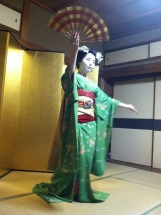By: Lauren and Michaela
Wish Upon a Star
Where It All Began
Magic Never Ends
Five of us went to the most magical place today, which was Tokyo Disney! The weather wasn’t in our favor but that didn’t stop us from having a Disney day. We navigated ourselves efficiently in and out of the transportation systems and arrived to Disneyland. The rides did related to what they have back in the U.S. but the experience was way better since we were in Tokyo, Japan. We went on many rides, had ice cream in the shapes of Disney members, and got a tour of the Tokyo Disney Castle. We tried to get in line to take a picture with Mickey but the line was quite slow. In the end, we had a lot of fun and also got some fun souvenirs to take home.
For those of us who didn’t go to Tokyo Disney, we spent the first half of the day exploring the Tsukiji Fish Market. The Fish Market is the largest wholesale seafood and fish market in the world—it’s like one big farmer’s market that specializes in fish! It originally came to be during the Edo period when fishermen were hired to provide food for those in the castle. All the fish that wasn’t sold to the upper-class was brought under the Nihonbashi bridge, where a fish market called uogashi—meaning “fish quay”—developed. It soon became the largest fish market in the world. However, when the area was damaged due to a serious earthquake, it was relocated to its current location in Tsukiji.
Because admittance to the actual fish market is prohibited unless you show up in the wee hours of the morning and happen to snag a spot in one of the small, exclusive tour groups, we just explored the outer shopping and food areas. (We didn’t think waking up at 4 a.m. to stare at fish seemed like something any of us would want to do.) The streets were so full of people and fish that it was hard to know which way to look! Mitch, Tyler, and I stopped at a sushi restaurant to get breakfast sushi, which was highly recommended by previous market goers. And they couldn’t have been more right: the sashimi we purchased was fresh from the auction that morning and absolutely melted in our mouths. I personally could have sat there and eaten all day, but I wasn’t sure how to say, “Excuse me, please never stop feeding me.” in Japanese, so we moved on to your next venue: the Studio Ghibli Museum.
For those of you who aren’t familiar with Studio Ghibli, it’s basically the Disney/Pixar of Japan. Founded by Hayao Miyazaki, Studio Ghibli is famous for its anime (cartoon) movies, which usually revolve around magic meeting the modern world. Though beautiful to look at and full of fun moments for everyone, Studio Ghibli specializes in telling a message about political/environmental issues, personal growth, and teaching Japanese culture and tradition. Some of their more popular movies in the United States include My Neighbor Totoro (where their logo derives), Kiki’s Delivery Service, and Spirited Away, which won an Academy Award for Best Feature Animation.
Because Mr. Miyazaki is so in love with nature, it’s only natural (HA) that the museum is located in a park down the street from the train station. However, we happened to get a little lost on our way there and ended up on the other side of town. We did, however, happen to walk by a small house with a golden nameplate reading “Miyazaki”, making us all wonder if our getting lost actually led us to the famous director’s house!
Once we gathered our bearings and made it to the museum, it was absolutely magical. Obviously made with children in mind, it has a certain whimsy that Studio Ghibli could accomplish. Unfortunately, photographs were not allowed inside the building, which makes sense because any visitor could spend days taking pictures of all the drawings, statues, and exhibits inside. A special treat for visitors is a small theater which plays one short film every day, which can only ever be seen at the museum. It was, though, in Japanese, so we could only enjoy the visual aspects and overall plot development!
I couldn’t have asked for a better way to spend my last day in Tokyo, experiencing the magic that I’ve grown up admiring for years first hand.
Ryōgoku Kokugikan Sumo Hall brought us all together to witness Japan’s most renowned sport. Wrestlers attempt to force another wrestler out of a circular ring called the dohyo or to touch the ground with anything other than the soles of the feet. If their hands or knees fall the ground, the opposite wrestler wins. The sport includes many ritual elements, such as the use of salt purification, ritual dances, and bow ceremony for the winner at the end.
 Sitting in the second level in front of the balcony we got a good view of both wrestlers on each side of the ring. When entering the circle, wrestlers would get all psyched by slapping themselves and getting pumped up by jumping around. They took a handful of salt and threw it into the ring. The throwing of salt and stamping their feet, sumo try to get rid of evil on the ground and purify the ring before the match.
Sitting in the second level in front of the balcony we got a good view of both wrestlers on each side of the ring. When entering the circle, wrestlers would get all psyched by slapping themselves and getting pumped up by jumping around. They took a handful of salt and threw it into the ring. The throwing of salt and stamping their feet, sumo try to get rid of evil on the ground and purify the ring before the match.
A group of us were beating one yen based on who would win the match just to make it more interesting. Mitch had a favorite Sumo wrestler called Endo. He won his match which ended in five seconds. Most of the matches ended quickly. However, when there was two wrestlers in the ring longer, the crowd began cheering louder and the suspense rose in the stadium. The east was winning more matches compared to the west tonight. At the very end, there was a bow-twirling ceremony performed. This ended our exciting night in Tokyo and our last night in Japan.
Fat men in diapers
Pushing each other around—
Who makes up this stuff?


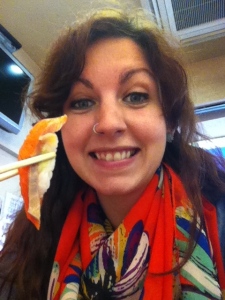
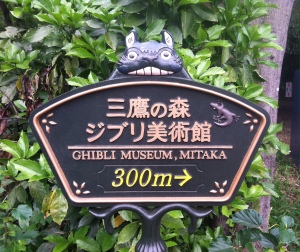
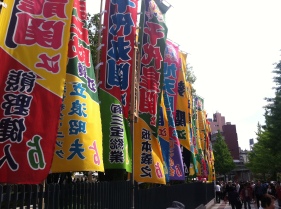





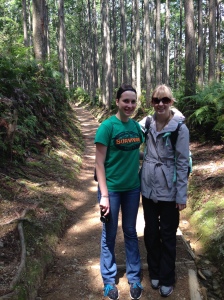
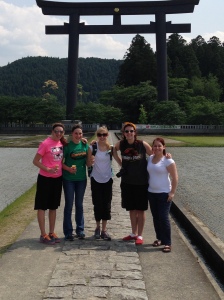
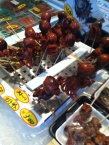 After a long day of traveling and ridding the bullet train we arrived in Kyoto. We got off and walked around Kyoto Station and viewed the architecture and sky gardens. Then, we ventured to Teramachi Street and got a smell of the side shops/markets which was very busy given that it was Golden Week. In Teramachi Street, we saw things like octopi on a stick along with the replica of the famous crab.
After a long day of traveling and ridding the bullet train we arrived in Kyoto. We got off and walked around Kyoto Station and viewed the architecture and sky gardens. Then, we ventured to Teramachi Street and got a smell of the side shops/markets which was very busy given that it was Golden Week. In Teramachi Street, we saw things like octopi on a stick along with the replica of the famous crab.  We have seen a lot of Buddha statues so far and today our tour guide said that at most statues you can make a wish, but first you should look at the position of their hands. The hand position that the Buddha had today represented “picking up spirits” so you don’t want to make a wish at that Buddha!
We have seen a lot of Buddha statues so far and today our tour guide said that at most statues you can make a wish, but first you should look at the position of their hands. The hand position that the Buddha had today represented “picking up spirits” so you don’t want to make a wish at that Buddha! 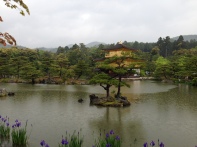 Kinkaku (The Golden Pavilion)/Rokuon-ji Temple: Kinkakuji, the Temple of the Golden Pavilion, is rightly one of Kyoto’s most famous attractions. The pavilion was built by a samurai shogun who retired and became a Buddhist monk. He wanted a place to relax and entertain Chinese messengers. It was also the setting for one of the strangest and saddest stories in the city’s history. In 1950, a monk with a mental disorder burned down the pavilion before attempting to commit suicide. The outside of the temple is made of gold leaf. It was located right next to a small pond area that had little islands all around, each overflowing with beautiful views. Apparently from the top of the temple, the view of the pond area and the islands are supposed to look like the entire island of Japan.
Kinkaku (The Golden Pavilion)/Rokuon-ji Temple: Kinkakuji, the Temple of the Golden Pavilion, is rightly one of Kyoto’s most famous attractions. The pavilion was built by a samurai shogun who retired and became a Buddhist monk. He wanted a place to relax and entertain Chinese messengers. It was also the setting for one of the strangest and saddest stories in the city’s history. In 1950, a monk with a mental disorder burned down the pavilion before attempting to commit suicide. The outside of the temple is made of gold leaf. It was located right next to a small pond area that had little islands all around, each overflowing with beautiful views. Apparently from the top of the temple, the view of the pond area and the islands are supposed to look like the entire island of Japan. Nijo Castle: Built in 1603 for the first Tokugawa Shogun then completed in 1626. The structure of the castle was designed to defend the shogun that lived there. The castle was surrounded by a mote and strong walls. Inside the building, were lavish paintings and carvings which were meant to intimidate guests or invaders. Speaking of invaders, parts of the house were designed to alert the samarai when invaders arrived. A special feature is the nightingale floor. It squeaks like nightingale when people walk on it. This is to prevent assassinations.
Nijo Castle: Built in 1603 for the first Tokugawa Shogun then completed in 1626. The structure of the castle was designed to defend the shogun that lived there. The castle was surrounded by a mote and strong walls. Inside the building, were lavish paintings and carvings which were meant to intimidate guests or invaders. Speaking of invaders, parts of the house were designed to alert the samarai when invaders arrived. A special feature is the nightingale floor. It squeaks like nightingale when people walk on it. This is to prevent assassinations. 